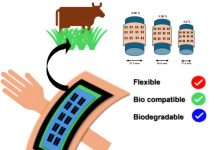
Imagine you could wear your gadgets like clothes or fold up your electronics like a piece of paper.
Sounds like something from a sci-fi movie, right?
Well, scientists are making this future possible, starting with something as small but essential as a mini-inductor.
A team of researchers has created a tiny, bendy power booster that could revolutionize how our devices get their energy.
Inductors are not something you hear about every day, but they are everywhere – in your phone, your laptop, and even your car.
They help manage power and signals, making sure everything runs smoothly without interference from other parts of the device.
The problem with traditional inductors is they’re rigid and can leak magnetic energy, which can mess with other electronic components. Plus, they’re not great for making gadgets smaller and more flexible.
Enter Prof. Wang Junqiang and his team from the Ningbo Institute of Materials Technology and Engineering.
They’ve come up with a game-changer: a mini-inductor made from a special kind of material that’s both flexible and super-efficient at storing energy.
This new mini-inductor is made from amorphous alloys, a type of metal that doesn’t have a set crystal structure, making it more flexible than the usual materials.
Using a very precise laser, the team shapes these alloys into thin ribbons without losing their unique properties. This method keeps the metal bendy and prevents it from becoming brittle – a common issue with traditional materials.
What’s really cool about this new inductor is that it barely leaks any magnetic energy, thanks to the special metal it’s made from. This means it can work really well even in small spaces, making it perfect for all kinds of electronics, from wearable devices to the next generation of smartphones.
The numbers speak for themselves: this tiny powerhouse can handle about 10 times more energy than the inductors we’re used to, and you can stretch it to three times its size without breaking it.
Even after bending it back and forth thousands of times, it barely loses any of its power-boosting abilities.
This breakthrough is more than just a technical win; it’s a peek into a future where electronics are not just portable but truly wearable and flexible.
With innovations like the amorphous mini-inductor, that future is getting closer every day.
The work of Prof. Wang and his team not only opens up new possibilities for how we design and use our gadgets but also shows how the tiniest components can have a huge impact on the technology of tomorrow.
The study was published in Advanced Functional Materials.



